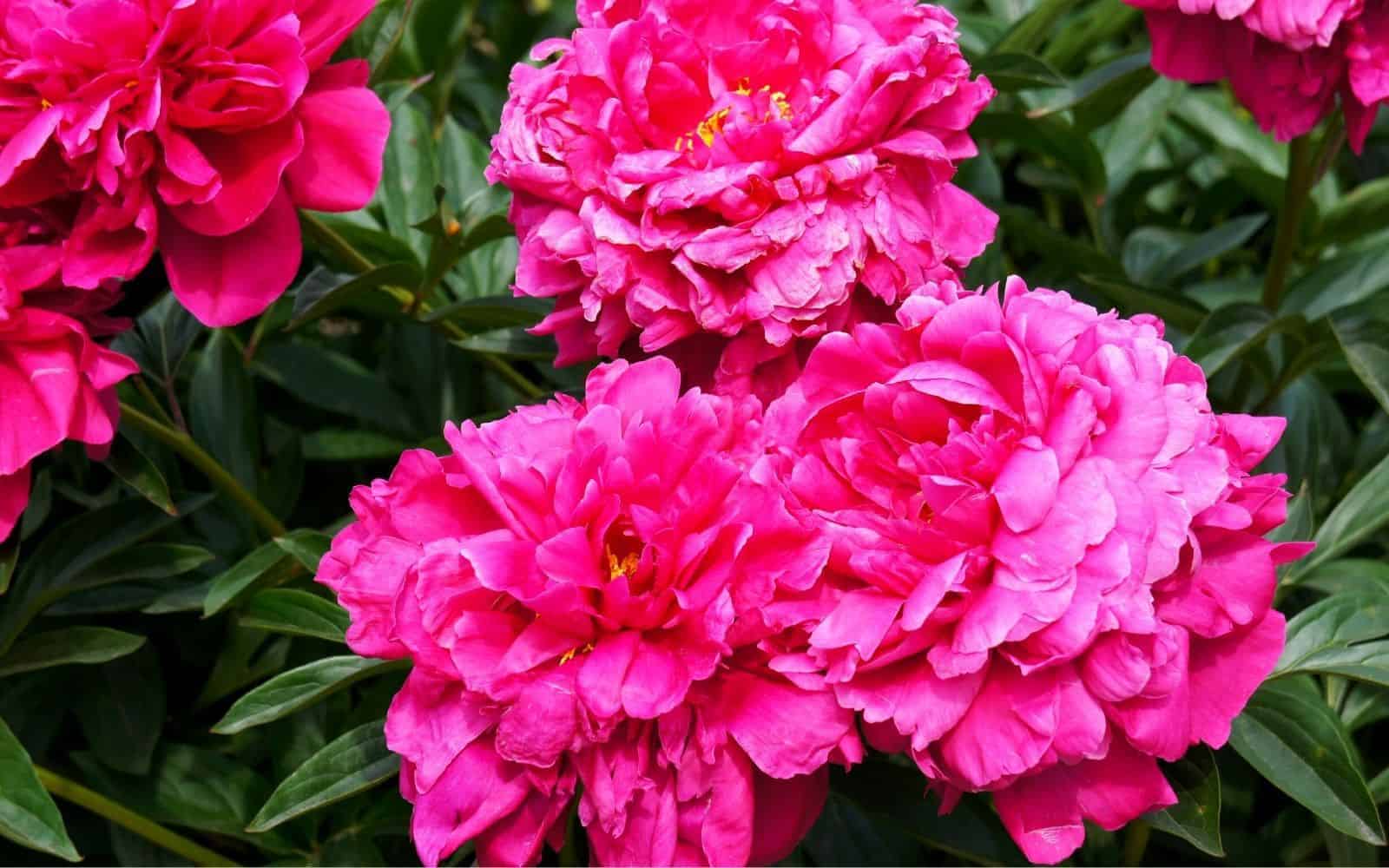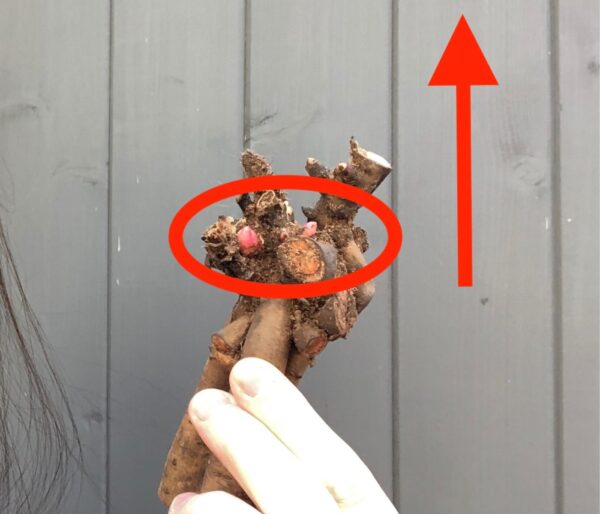Kansas peony is a bright red-pink double peony variety with loose frilly petals. These cheerful magenta flowers can reach 8″ across! Plants grow to be between two and three feet tall, with ornamental dark green leaves and strong stems.
Kansas peonies bloom best in full-sun planting locations and with moist, nutrient-rich soil. The Kansas peony is a cultivar of Paeonia lactiflora bred in Topeka, Kansas, in 1940 by American peony breeder Myron Bigger.
Kansas peony basics
Kansas peonies are frilly red-pink peony flowers with double-petal blooms. The Kansas Peony was bred by Myron D. Bigger of Topeka, Kansas, and was introduced in 1940. The Kansas Peony received the 1957 Gold Medal from the American Peony Society. Myron Bigger became the president of the American Peony Society from 1958-1959.
Peony ‘Kansas’ has large double flowers, reaching 8″ across. These large pink-red blooms are supported by very strong upright stems. While the flowers do not have a floral or any delightful fragrance, they have the appearance of old-fashioned garden roses. The plant also showcases dark, shiny, lobed leaves in the form of foliage and exceptionally strong stems.
Kansas flowers are called “doubles” as they have multiple layers of petals. These big, fluffy, puffball-like flowers are among the largest types of peony blooms (and certainly the heaviest!). Other types of double peonies include Karl Rosenfeld peony, Sarah Bernhardt peony, and Festiva Maxima peony.

Peony classification
Kansas peonies (Paeonia lactiflora ‘Kansas’) are herbaceous perennial plants with full double-type peony flowers that bloom early in peony season (typically early-mid spring).
Peonies come in six main flower forms: single, anemone, Japanese, semi-double, bombe, and full double. Full double peonies like ‘Kansas’ are known for their voluminous layers of petals. In this flower type, all stamens and carpels in the center of the flower are transformed into petals. The blooms are full and frilly!

Planting Kansas peonies
Like most peony plants, Kansas requires only minimal maintenance as long as they’ve been planted in the right spot. The Kansas peony only blooms in spring but is resilient throughout the year.
Planting location
Plant peonies in hardiness zones 2-8. Their preferred garden zone is usually 4-7, but Kansas plants are a little more resistant to the heat than your average peony, meaning that they tend to thrive in zone 8 a little better than most. They need a cold period to bloom, so avoid planting peonies in zones 9+ unless you can artificially chill the plants.
Within your garden, this herbaceous peony grows best in a spot with plenty of bright sunshine and deep soil with good drainage. In the hottest zones (7-8), consider planting them in an area that receives light afternoon shade or partial shade if you’re worried about being able to water consistently.
When planting more than one peony, plant them three to four feet away from each other for the best results.
Peonies like soil with a neutral to slightly acidic pH that is deep and drains well. If you have soil that is capable of growing plants without fertilizer, then there is no reason to use more than a tiny bit of fertilizer for these flowers.
When to plant peonies
The best time to plant peonies is early spring planting or in the fall. The best time to move them is in early fall (although they don’t love being moved). It is important that the root system has at least six weeks to settle in before the ground freezes.
Also, be sure to handle the roots carefully if you’re planting a bare-root peony. When you get a peony root, it should have at least three to five eyes (small red buds). Be gentle; the roots are delicate.
How to plant peonies
Dig a hole large enough to accommodate the roots. Set the root so the eyes are 1-2 inches below the soil surface. If planted too deep, they may not bloom.
Backfill the hole after positioning the root. Gently cover the root with soil. Tamp down lightly to remove air pockets.
After planting, water well to settle the soil around the roots. Apply a light layer of mulch to conserve moisture and keep weeds down. Avoid piling mulch against the plant’s stem if the aboveground foliage is already present.
Caring for peonies
As peonies grow, they might need support to keep their heavy blooms upright. Install a peony ring or stakes if necessary.
Many new peony growers notice ants and wonder if they are a problem. Often seen on peony buds, ants are usually harmless. They’re attracted to the nectar produced by the buds, not the plant itself. No control is necessary for ants, as they don’t damage the plant.
There’s no need to mulch them heavily, even in the winter. Light mulching will be fine if you do decide to mulch over them in colder areas (zones 2-4). Peonies are very cold-hardy!
Along with trimming back dying blossoms, you should also trim the peony plant’s foliage to the ground before each winter to protect it from overwintering pests.
Pests and diseases
Herbaceous peonies, while robust, can be affected by certain pests and diseases. Understanding and managing these issues ensures healthy, thriving plants.
Botrytis blight is a fungal disease that is common in peonies. It causes brown, wilted buds and blackened stems. Wet, cool spring weather often exacerbates this problem. To manage it, ensure good air circulation by spacing plants properly and cleaning up plant debris. Fungicide applications can also be effective.
Another fungal disease, peony wilt, leads to wilted, discolored foliage and stems. Prevention is similar to botrytis blight—promote good air circulation and practice cleanliness around plants. Fungicides can help if applied early.
Leaf blotch is a different fungus that typically appears as red or purple spots on leaves and stems. It’s more cosmetic than harmful. Good sanitation and removing affected foliage can control leaf blotch.
Overly wet soil can cause root rot in peonies. Symptoms include wilting and yellowing leaves. The key to preventing root rot is ensuring well-draining soil and avoiding over-watering.
While most peony diseases fall into the fungal category, there are also viral diseases to consider. Peony ringspot virus causes ring-shaped or line-patterned spots on leaves. There’s no cure for these viral diseases, so infected plants should be removed to prevent spread.
Regular monitoring of your peonies can help you spot and address these issues early, ensuring your plants remain healthy and vibrant. Remember, healthy plants are better equipped to withstand pests and diseases, so proper care is your first line of defense.







